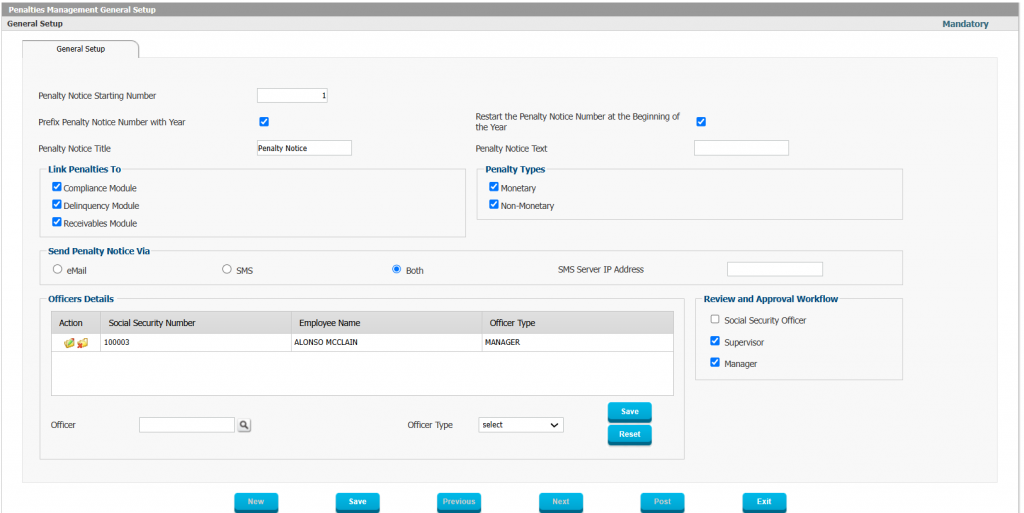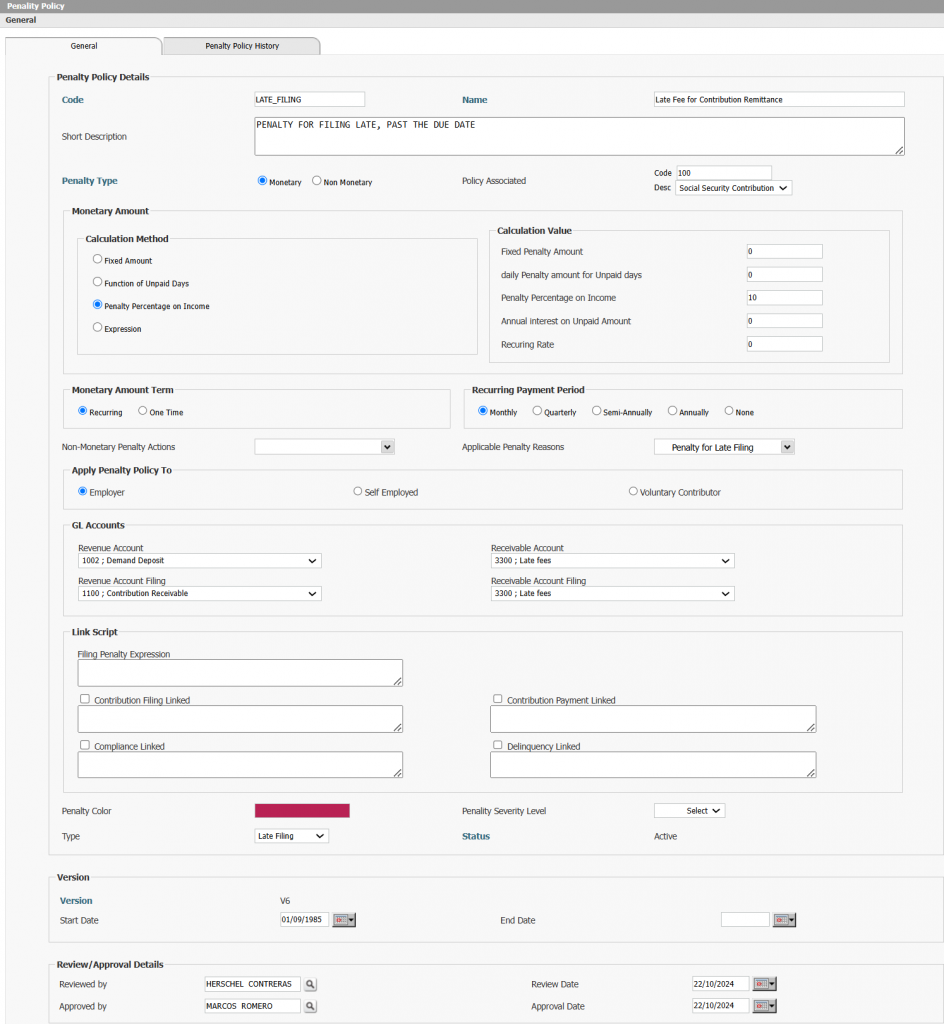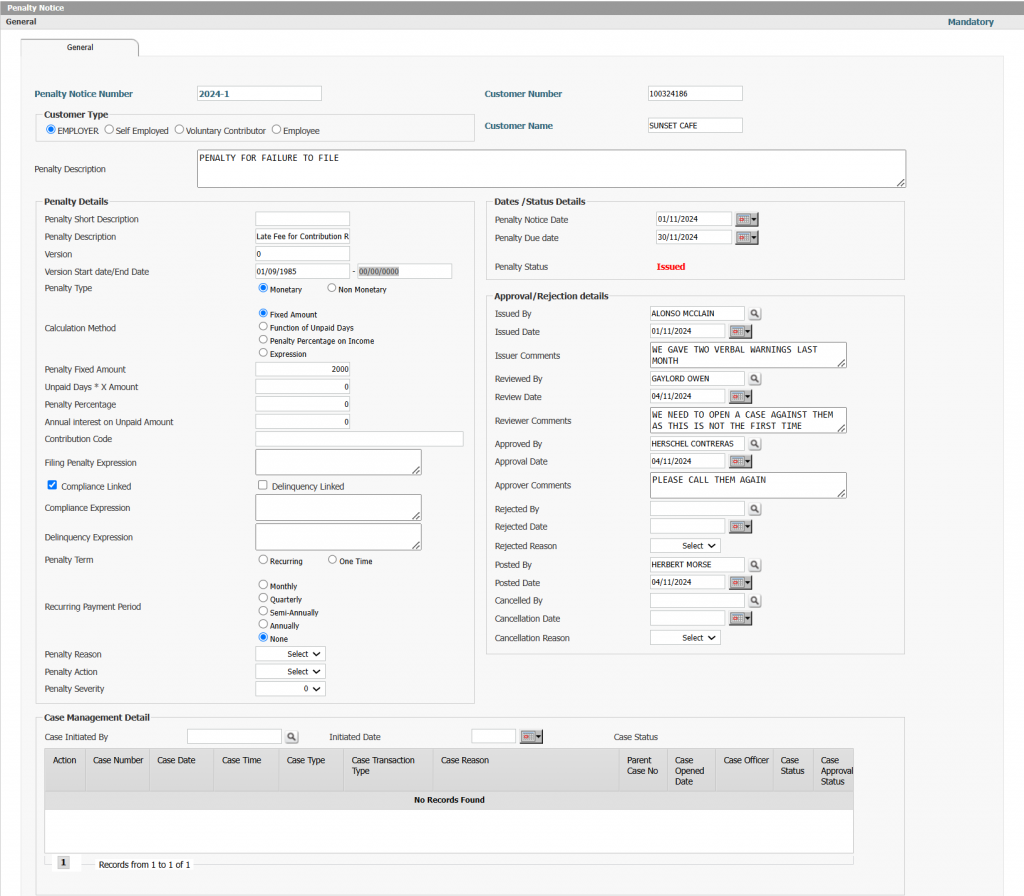While penalties are a universal enforcement tool in social security systems, their application, calculation methods, and severity vary significantly across countries. Here’s a closer look at how late filing and late payment penalties are managed in the United States, United Kingdom, and Canada:
United States
In the U.S., the Internal Revenue Service (IRS) enforces penalties for late filing and late payment of Social Security and Medicare contributions, which are included in the payroll tax system under the Federal Insurance Contributions Act (FICA). For self-employed individuals, this falls under the Self-Employment Contributions Act (SECA).
- Late Filing Penalty:
- The penalty for failing to file payroll taxes, which include Social Security contributions, is 5% of the unpaid tax amount per month or part of a month, up to a maximum of 25% of the unpaid tax.
- If the filing is more than 60 days late, the minimum penalty is the smaller of $435 or 100% of the unpaid tax (as of 2024).
- Late Payment Penalty:
- A penalty of 0.5% of the unpaid tax per month is applied, with a maximum of 25%.
- The penalty rate increases to 1% per month if the taxpayer fails to pay after receiving a demand for payment from the IRS.
- Interest on Late Payments:
- Interest is charged on unpaid taxes, calculated daily based on the federal short-term rate plus 3%. This compounds the overall financial impact for individuals and employers who fail to meet deadlines.
United Kingdom
In the UK, the penalties for late submission and late payment of National Insurance Contributions (NICs) are enforced by Her Majesty’s Revenue and Customs (HMRC). These penalties are particularly relevant for employers and self-employed individuals.
- Late Filing Penalty:
- Employers who fail to submit Real-Time Information (RTI) submissions for NICs by the deadline face a penalty based on the number of employees:
- 1-9 employees: £100 per late submission.
- 10-49 employees: £200.
- 50-249 employees: £300.
- 250 or more employees: £400.
- Penalties increase with repeated offenses, encouraging prompt filing.
- Employers who fail to submit Real-Time Information (RTI) submissions for NICs by the deadline face a penalty based on the number of employees:
- Late Payment Penalty:
- Penalties for late NIC payments depend on the delay period:
- Up to 30 days: No penalty (interest applies).
- 31 days to 6 months: 1% of the unpaid contributions.
- 6 to 12 months: 2% of the unpaid contributions.
- Beyond 12 months: 3% of the unpaid contributions.
- Penalties for late NIC payments depend on the delay period:
- Interest Charges:
- HMRC also charges interest on late payments at the Bank of England base rate plus 2.5%.
Canada
In Canada, penalties for late filing and late payment of contributions to the Canada Pension Plan (CPP) are managed by the Canada Revenue Agency (CRA). These penalties apply to both employers and self-employed individuals who fail to remit their share of CPP contributions.
- Late Filing Penalty:
- Employers must file their T4 slips (detailing employee contributions) by the last day of February. The penalty is calculated based on the number of slips filed late:
- $100 per late slip for up to 5 slips.
- Increasing rates for larger numbers of late slips, with penalties reaching as high as $7,500 for substantial delays.
- Employers must file their T4 slips (detailing employee contributions) by the last day of February. The penalty is calculated based on the number of slips filed late:
- Late Payment Penalty:
- A penalty of 10% of the unpaid CPP contributions is imposed if the payment is more than 7 days late.
- A second penalty of 20% applies if the employer is repeatedly late (within a calendar year).
- Interest on Late Payments:
- Interest is charged on unpaid contributions at the CRA’s prescribed rate, which is adjusted quarterly based on market conditions.
Key Takeaways and Contrasts
- Calculation Methods:
- The U.S. focuses on monthly percentages with separate rates for late filing and late payment.
- The UK employs tiered penalties based on the size of the employer and duration of the delay, emphasizing proportionality.
- Canada combines fixed penalties for late filing with significant percentage-based penalties for unpaid contributions, making repeat offenses particularly costly.
- Severity:
- While all systems enforce penalties to deter non-compliance, Canada imposes some of the highest penalties for late payment, particularly for repeat offenses.
- In the UK, smaller businesses benefit from reduced penalties for late filing compared to larger employers.
- Integration with Interest:
- In all three countries, interest is a critical component of late payment penalties, further increasing the financial burden on non-compliant parties.
By comparison, the Interact SSAS Penalties Management Module is designed to accommodate these diverse approaches, offering flexibility in defining calculation methods and interest rates. This ensures compatibility with a wide range of penalty policies and practices across jurisdictions, supporting social security organizations worldwide in enforcing compliance effectively.
A Comprehensive Overview of Penalties Management in Interact SSAS
In modern social security systems, penalties serve as both a deterrent and a corrective mechanism for ensuring compliance with regulations. The Penalties Management Module of Interact SSAS is a sophisticated and highly configurable system designed to address every aspect of penalty administration, from policy definition to penalty notices and processing. This blog takes an in-depth look at the functionality of Interact SSAS for managing penalties, focusing on its features and workflows as depicted in the penalty setup and penalty notice screenshots.
While penalties are applied in all countries when the required contributoin information is not filed or paid on time, the manner in which they are calculated, applied, and processed may differ across countries. Sometimes enforcement is very strict, while other times it is more discretionary. In discretionary cases, the user will need to be able to manually initiate the process and handle exceptions or voiding/cancellation of penalties. In some countries the calculation is based on a straight-forward 10% of unpaid amounts, while in other countries there may be compound interest involved and more complex calculations. For this reason, Interact SSAS supports a policy-based configuration of the penalties with the ability to use fixed amounts, percentages or complex formulas using scripts and expressions to handle any type of scenarios.
Introduction to Penalties in Social Security Administration
Penalties are essential for enforcing compliance among employers, self-employed individuals, voluntary contributors, and employees. In social security systems, penalties may be applied for reasons such as late filing of contributions, delayed payments, or non-compliance with audit requirements. These penalties can be:
- Monetary: Fines or fees calculated based on fixed rates, unpaid amounts, or percentages.
- Non-Monetary: Actions such as the suspension of benefits or revocation of licenses.
The Penalties Management Module in Interact SSAS is engineered to manage these scenarios efficiently through automation, integration, and flexibility.
Key Features and Setup of Penalty Management in Interact SSAS
- General Setup
The General Setup screen establishes the foundation for penalty management. Key elements include:
- Penalty Notice Starting Number:
- Administrators can define the starting number for penalty notices, ensuring that each notice has a unique identifier.
- Option to prefix the notice number with the year helps in organizing and tracking penalties issued annually.
- The option to restart numbering at the beginning of each year maintains consistency in records.
- Penalty Types:
- Supports both monetary and non-monetary penalties.
- Monetary penalties may involve fixed amounts or calculations based on unpaid contributions, while non-monetary penalties can include actions like termination of benefits or revocation of privileges.
- Integration with Modules:
- Penalties can be linked to the Compliance Module, Delinquency Module, or Receivables Module, ensuring seamless workflows.
- For example, late filing penalties identified in the Compliance Module automatically trigger penalty notices.
- Notification Methods:
- Penalty notices can be sent via email, SMS, or both.
- The inclusion of an SMS Server IP Address allows for direct integration with messaging systems.
- Officer Management:
- A grid interface displays officer details, including their roles (e.g., manager, reviewer).
- Officers can be added, edited, or removed as needed.
- Approval Workflow:
- Defining Penalty Policies
The penalty policy definition is central to customizing penalty rules for different scenarios. Key elements include:
- Penalty Details:
- Policy Code and Name: Every penalty is assigned a unique code and descriptive name.
- Monetary or Non-Monetary: The system allows flexibility in applying either type of penalty.
- Applicable Entities: Penalties can target employers, self-employed individuals, voluntary contributors, or employees.
- Calculation Methods:
- Options for calculating penalties include:
- Fixed Amount: A standard fee, e.g., $100 for late filing.
- Function of Unpaid Days: Charges based on the number of days a payment is overdue.
- Penalty Percentage on Income: A percentage-based penalty linked to declared earnings.
- Expression: Custom formulas for advanced calculation using expressions or scripts.
- Options for calculating penalties include:
- Recurring vs. One-Time:
- Penalties can be applied as one-time charges or recurring payments (monthly, quarterly, annually).
- GL Accounts:
- Specific accounts can be linked for revenue and receivables, ensuring proper accounting for penalty payments.
- Linked Modules:
- Policies can be associated with Contribution Filing, Contribution Payments, Compliance, or Delinquency workflows.
- Review and Approval:
Penalty Notices: Issuance and Processing
The Penalty Notice Management screen provides an intuitive interface for creating and processing penalty notices. Key functionalities include:
- Penalty Notice Details
- Penalty Notice Number:
- Auto-generated based on the setup, ensuring unique identification.
- Example: “2024-14” represents the 14th penalty issued in 2024.
- Customer Information:
- Displays customer type (Employer, Self-Employed, Voluntary Contributor, or Employee), customer number, and name.
- Example: A penalty issued to “Massive Results Inc.” with Customer Number “100994198.”
- Penalty Description:
- Describes the reason for the penalty, such as “Late Fee for Contribution Remittance.”
- Penalty Details
- Penalty Type:
- Differentiates between monetary and non-monetary penalties.
- Example: A monetary penalty for delayed remittance.
- Calculation Method:
- Provides options like fixed amount or penalty percentage on unpaid income.
- Allows input of specific values for unpaid days, penalty percentage, and annual interest.
- Penalty Term:
- Specifies whether the penalty is recurring or one-time.
- Recurring penalties can be configured for payment periods (monthly, quarterly, annually).
- Linkage with Compliance and Delinquency:
- Indicates whether the penalty is tied to compliance or delinquency issues.
- Severity and Action:
- Includes fields for penalty reason, penalty action, and severity level, which determine the impact and urgency of the notice.
- Dates and Status
- Tracks critical dates:
- Notice Date: When the penalty was issued.
- Due Date: The deadline for resolving the penalty.
- Penalty Status:
- Real-time updates such as “Issued,” “Pending Approval,” or “Resolved.”
- Approval and Rejection
- Issued By: Identifies the officer who issued the notice.
- Review and Approval:
- Details the reviewers and approvers, including dates and comments.
- Rejection:
- If a notice is rejected, the system records the reason and reviewer comments.
Integration with Other Interact SSAS Modules
- Compliance Management:
- Penalties for non-compliance (e.g., missed audit deadlines) are triggered automatically.
- Delinquency Management:
- Late payments or filings flagged as delinquent generate penalty notices.
- Receivables Management:
- Invoices for monetary penalties are seamlessly created and tracked.
- Contribution Filing and Payments:
- Late filing or payment penalties are calculated and applied directly during the filing process.
Benefits of the Penalties Management Module
- Automation:
- Reduces manual intervention by automating penalty calculation, issuance, and processing.
- Configurable Policies:
- Administrators can tailor penalty rules to meet regulatory requirements.
- Transparency:
- Detailed audit trails and approval workflows ensure accountability.
- Improved Communication:
- Automated notifications via email and SMS improve stakeholder engagement.
- Seamless Integration:
- Links with other SSAS modules for end-to-end management of compliance and delinquency.
Conclusion
The Penalties Management Module in Interact SSAS is a robust and comprehensive tool for managing social security penalties. By automating penalty creation, integrating seamlessly with other modules, and offering flexible configurations, it supports social security administrations in maintaining compliance and enforcing regulations effectively. With its intuitive design and advanced features, the module ensures transparency, efficiency, and accountability, making it a vital component of modern social security systems.


